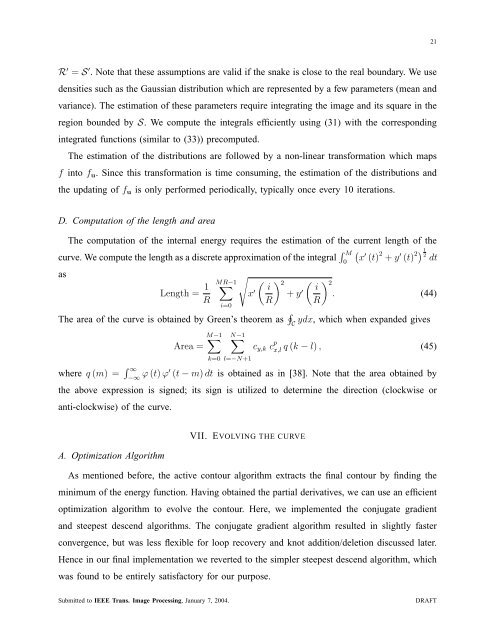Efficient energies and algorithms for parametric snakes - EPFL
Efficient energies and algorithms for parametric snakes - EPFL
Efficient energies and algorithms for parametric snakes - EPFL
You also want an ePaper? Increase the reach of your titles
YUMPU automatically turns print PDFs into web optimized ePapers that Google loves.
21R ′ = S ′ . Note that these assumptions are valid if the snake is close to the real boundary. We usedensities such as the Gaussian distribution which are represented by a few parameters (mean <strong>and</strong>variance). The estimation of these parameters require integrating the image <strong>and</strong> its square in theregion bounded by S. We compute the integrals efficiently using (31) with the correspondingintegrated functions (similar to (33)) precomputed.The estimation of the distributions are followed by a non-linear trans<strong>for</strong>mation which mapsf into f u . Since this trans<strong>for</strong>mation is time consuming, the estimation of the distributions <strong>and</strong>the updating of f u is only per<strong>for</strong>med periodically, typically once every 10 iterations.D. Computation of the length <strong>and</strong> areaThe computation of the internal energy requires the estimation of the current length of thecurve. We compute the length as a discrete approximation of the integral ∫ M(0 x ′ (t) 2 + y ′ (t) 2) 12dtasLength = 1 RMR−1∑i=0√x ′ ( iR) 2+ y ′ ( iR) 2. (44)The area of the curve is obtained by Green’s theorem as ∮ ydx, which when exp<strong>and</strong>ed givesCArea =M−1∑N−1∑k=0 l=−N+1c y,k c p x,lq (k − l) , (45)where q (m) = ∫ ∞−∞ ϕ (t) ϕ′ (t − m) dt is obtained as in [38]. Note that the area obtained bythe above expression is signed; its sign is utilized to determine the direction (clockwise oranti-clockwise) of the curve.VII. EVOLVING THE CURVEA. Optimization AlgorithmAs mentioned be<strong>for</strong>e, the active contour algorithm extracts the final contour by finding theminimum of the energy function. Having obtained the partial derivatives, we can use an efficientoptimization algorithm to evolve the contour. Here, we implemented the conjugate gradient<strong>and</strong> steepest descend <strong>algorithms</strong>. The conjugate gradient algorithm resulted in slightly fasterconvergence, but was less flexible <strong>for</strong> loop recovery <strong>and</strong> knot addition/deletion discussed later.Hence in our final implementation we reverted to the simpler steepest descend algorithm, whichwas found to be entirely satisfactory <strong>for</strong> our purpose.Submitted to IEEE Trans. Image Processing, January 7, 2004.DRAFT
















